|
Charlotte Johnson with an 8 lbs. 4 oz. TrophyCatch bass caught on Fellsmere Reservoir.
TrophyCatch Season 7 is now well past the halfway mark and there are plenty of prizes that are still up for grabs. A trophy — even a Hall of Fame bass — can show up at any time in Florida! So make sure that your camera and scale are handy at all times! Totals since the program's beginning in 2012 (as of May 2019) are:
- 7,133 Lunker Club (8 - 9.9 lbs.) bass
- 1,712 Trophy Club (10 - 12.9 lbs.) bass
- 65 Hall of Fame (13+ lbs.) bass
A grand total of 8,910 trophy bass over 8 pounds have now been successfully caught, documented, and released for prizes from TrophyCatch. This large amount of data is being used to guide FWC research projects on largemouth bass and freshwater fisheries. TrophyCatch's top ten water bodies are listed below:

Stay up to date on TrophyCatch, partner promotions, special events, and our top producing anglers by liking our TrophyCatch Facebook page and subscribing to the TrophyCatch YouTube Channel. Who knows — you might see us bragging about you and your trophy photo here soon! |
|
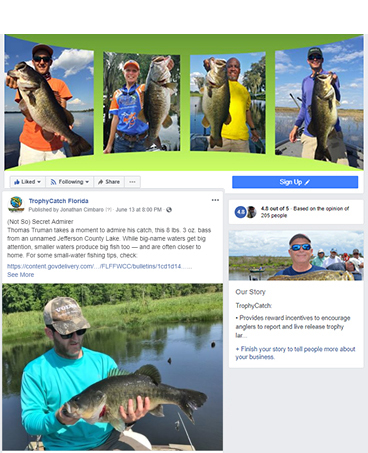 |
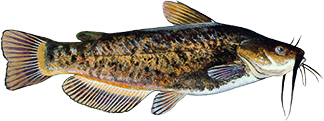
Size: The state record is 7.02 pounds. The Big Catch minimum qualifying sizes are 2.00 pounds or 16 inches for adults, and 1.50 pounds or 12 inches for youth (BigCatchFlorida.com).
Identification and similar species: The barbells make this fish easy to identify as a catfish. Chin barbels on browns are dark-pigmented, not whitish as with Yellow Bullhead. The sides of brown bullheads have a distinct, irregular brownish mottling over a light background. The belly is creamy white. They have square tails.
|
Angling qualities: Fair fighters, they are easy to catch with baits such as worms, minnows, shrimp, chicken or beef liver, and commercial stinkbaits. They bite throughout the day, but fishing is best at night. Summer is an ideal catfishing time — just add a beach umbrella, lawn chair, and jug of tea or lemonade to your equipment checklist for a few hours of relaxing fun!
Where to catch them: Brown bullheads are common throughout the entire state. They generally inhabit still or slow-flowing warm waters in ponds, lakes, reservoirs, large rivers and sluggish streams.
Interesting facts: They are primarily bottom feeders, feeding mostly at night. Highly sensitive barbels enable them to smell a wide variety of food such as insects, plant material, carrion, small fish, snails, crayfish, worms and leeches.
Fish illustration by Duane Raver, Jr.
 |
|
The Big Catch angler recognition program helps you celebrate memorable-sized catches of 33 freshwater species! A qualifying submission nets you a personalized certificated suitable for framing and hanging. |
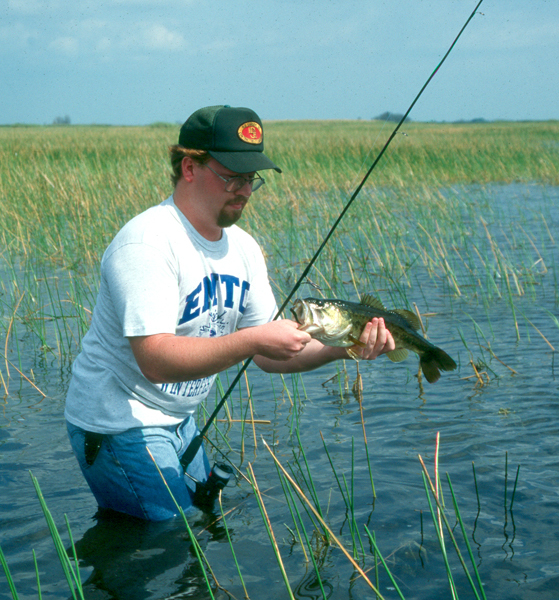
There are many reasons to bank fish. The most obvious is not owning a boat due to cost or storage space. Many waters don’t have ramps or are only accessible by foot. And you don’t always have the time to load up, launch, and retrieve a boat. But whether your boat-lessness is permanent or temporary, most anglers will find themselves working their feet instead of a trolling motor at least some of the time. Here’s how to take advantage of those times.
|
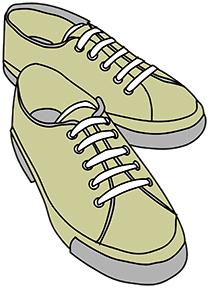
Footwear
Tennis shoes are probably the most readily available bank and wading shoes — you probably already own a pair. With our mild Florida climate, “sneakers” can be quite comfortable, even when wet. But that’s their main problem: they’re not waterproof, and even during warmer weather having to change out of wet socks and shoes is inconvenient. During cooler weather, wet sneakers can be downright cold. No matter how hard you try to stay dry, it always seems like your sneakers still end up getting wet.
You might think that the extremely popular modern sandal comes next. They’re great on the boat, and I use them exclusively when kayaking (which definitely involves some wading). However, the open design is simply not safe for at least some of the terrain I see nearly everywhere I bank fish. For beaches, yes — but for partly-wooded lake shores, rocky canal banks, and brushy pond edges, no.
|
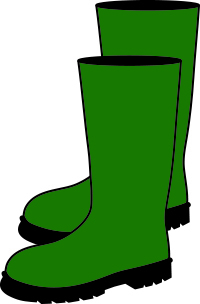
Rubber work boots are the next safe step up. They are dirt cheap, and you can even wade a bit into water almost a foot deep, while still staying dry! When you are limited to a brushy bank, being able to go out even a little bit into the water will often allow you to cast around or past bushes or other shoreline vegetation. You can also edge a little closer to offshore vegetation or cover that might be harboring big bass just out of reach of someone stuck on the bank. The disadvantages of plain rubber work boots, however, are several. They’re hot. They’ll fill with water like a pair of five-gallon buckets if you go too deep. They don’t fit your feet very tightly, which can leave a boot behind in deep mud, or cause heel blisters when covering harder terrain.
|

If you heed the unanimous advice of dozens of outdoors writers, you’ll eventually end up with a quality pair of waterproof outdoors boots. There are numerous options available, but I prefer knee-high, form-fitting rubber boots that lace up. If you duck hunt, then odds are high that you already own a pair. The close-fitting ankles and lacing on these boots make sure they stay put, even when sucking a foot back up out of two-foot-deep mud. For less muddy or shallower use, most anglers will be more comfortable in waterproof leather boots which are cooler than rubber with more “breathability.” These usually have rubber soles, with leather uppers of various heights (you’ll pay more for taller boots, as I did for my knee-highs). Normal rubber soles with a deep tread will handle most lakeside terrain; felt or studded soles designed for northern rocky lakes and rivers are useless down here. While definitely easier on the feet, these boots require some maintenance, mainly of the leather uppers to keep them waterproof and supple. Even with care, they will eventually start to leak. Be aware that many boots come insulated or lined against the cold of northern climates; Florida sportsmen will want to make sure they buy uninsulated versions.
|

Due to the potential presence of alligators in any of Florida’s waters, my “wade fishing” goes no deeper than my knee-high boots. I am pretty cautious about doing even that or just walking the shoreline. Anyone near water should stay alert and exercise due caution at all times. For more tips on staying safe, see FWC’s Living with Alligators page.
|

Other equipment
Unless you’re fishing obstruction-free waters, medium to heavy rather than light tackle will be best-suited for bank angling. In a boat, you’re usually working fish away from cover out into open water, but from shore you’ll often have unavoidable obstructions to deal with. I prefer longer rods, which give me more reach and better control when I don’t have the option of dashing from one side of the boat to the other.
You’ll need some way to carry your lures and other fishing gear. A small tackle box works well for a start; what I’ll do is transfer a basic selection of lures for whatever I’m after from my “main” tackle box into my “carry” box. However, I’ve come to prefer a roomy waist tackle pack that is hands-free. Spacious fishing vests are also available — but hotter to wear. Speaking of which, a water bottle holder on your tackle pack or vest is a lifesaver for long treks from the car.
Note that wading staffs, a must for wade anglers up north, won’t provide much support in Florida with its soft, mucky bottoms. However, I carry a landing net and have found it’s long handle helpful for maintaining balance on canal banks.
Tactics
Most of these principles will apply equally to bank or boat fishing. You’ll be targeting obvious structure, and ideally you’ll try to line up your casts so that your lure spends more time in the strike zone than it does in “dead” water. However, the latter can be hard to accomplish from shore. Wading out slightly past shoreline brush, or closer to the far edge of shoreline weeds, will often help you place a cast parallel to the shoreline that will cover likely territory. Bank anglers also need to keep stealth in mind, keeping a low profile and walking softly in order to get close to their quarry without spooking it.
Flipping-style casts can be very important. If the shoreline is fairly brushy and you can’t wade past it, the only way to get a cast out may be to stick your rod tip past the brush and swing-cast left or right to likely spots along the shoreline. This is another reason I prefer a longer rod — preferably seven feet — for bank fishing. Another helpful technique is bouncing a lure off the surface so it can skitter farther under overhanging cover.
Weedless lures are more of a necessity when bank fishing. Shoreline structure and trees will be harder to avoid. And if you snag one, you’ll have a better chance of getting a weedless lure back than one with multiple treble hooks.
Playing a large fish will be more challenging from shore, because there will usually be more obstructions to deal with. Again, a longer rod will give more control, allowing you a bit more leeway in “steering” fish around or away from vegetation or shoreline brush. On the other hand, wading can put you closer to the action, and it can be quite exciting to have a large fish boiling the water right next to you before you manage to land it. A word of caution, however: yet another reason to make all your hooks barbless is the possibility of having a large fish brush you with a mouth full of trebles.
|
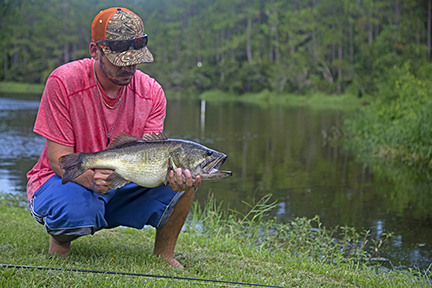 |
No boat needed to land big bass!
So whether you always fish from shore, or you’re just giving the bass boat a break, bank angling can provide some great rewards. These tips should help you to make the most of the experience!
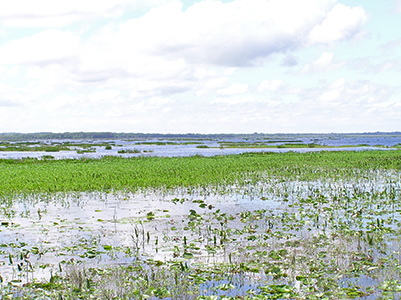
Size: 12,550 acres.
Location: Alachua County.
Description: Orange Lake is situated 15 miles southeast of Gainesville in southern Alachua County. At nearly 13,000 acres, it is the largest lake in FWC’s North Central Region. Orange has a storied reputation as one of the best freshwater fisheries in Florida for largemouth bass, black crappie, and bream when conditions are right. Because of its relatively shallow depth (6 feet average) and connection to the Floridan Aquifer through numerous sinkholes, water levels can be very dynamic, and habitat conditions on the lake can change dramatically. During periods of extended drought, the lake can drop low enough to eliminate access. Abundant rainfall, such as that which accompanies tropical storms or hurricanes, helps to replenish the lake. These cycles of drought and refill have been recorded on Orange Lake since the early to mid-1900’s, and they have likely been occurring before recorded history.
The lake’s fish populations have proven to be resilient in the face of such dramatic changes in water level, and it is likely that they even benefit from these periodic resets in habitat conditions. Since the most recent drought of 2012 and the refilling of the lake in 2013, fishing in Orange Lake has been getting better every year. Recent creel surveys (angler interviews) have shown excellent fishing for black crappie and bream. Anglers trolling or drifting jigs and minnows in open water do well for crappie in the fall and winter months. As the fish move into shallower waters in preparation for the spawn later in the spring, anglers do better targeting nearshore vegetation. Good catches of bluegill and redear sunfish can be had from spring through early fall as the fish congregate to spawn in nearshore vegetation. Live baits such as grass shrimp, crickets, or earthworms fished in open holes in the vegetation account for most of the fish. Although a little slower initially to rebound than the panfish, largemouth bass fishing can be described as excellent for both numbers and size of fish. Creel surveys, electrofishing surveys, TrophyCatch submissions, and bass tournament results have indicated a healthy bass fishery. In March 2019, Orange Lake yielded the second-heaviest bass ever submitted to the TrophyCatch program at 15.8 pounds. A remarkable five-bass tournament bag limit of 45.2 pounds was caught in Orange Lake in the same month. Bass anglers on Orange typically do well flipping soft plastics in and around emergent pads and floating vegetation mats, especially during the springtime spawn. Anglers should also target submerged vegetation such as coontail and hydrilla beds with spinnerbaits, lipless crankbaits, soft plastics, and topwater lures.
In addition to healthy populations of fish, Orange Lake’s abundant aquatic habitat supports excellent numbers of other wildlife. Waterfowl hunting, alligator hunting, frogging, and bird watching are also popular activities which draw many people each year. The lake can be accessed from Marjorie Kinnan Rawlings Park near the community of Cross Creek and at Heagy-Burry Park near the town of McIntosh, just off of US 441. The lake can also be accessed from nearby Lochloosa Lake via passage through Cross Creek. A handful of fish camps also provide launch opportunities on the lake for a nominal fee.
|
The sudden appearance of dead fish in a lake or canal causes considerable concern for most people. However, most fish kills result from natural causes. Too little oxygen in the water is the primary cause of fish kills in Florida. Cold weather also results in kills of non-native tropical fish that have become established here. Although a fish kill in any particular water is usually a rare event, a number of fish kills do occur across Florida each year, and summer is the time that most of them happen.
Low Dissolved Oxygen Fish Kills
Fish, like people, need oxygen to survive. Most dissolved oxygen (DO) in the water is produced by aquatic plants through photosynthesis, using sunlight energy to produce oxygen. At the same time, however, oxygen is being removed from the water by the respiration (breathing) of fish, plants, and other underwater inhabitants. Decomposition of plant and animal matter in the water also consumes oxygen.
Each water body usually undergoes a daily oxygen cycle. Under normal conditions, the DO in a water body is lowest in the morning just before the sun rises. As the sun comes up and aquatic plants begin to photosynthesize, the oxygen level rises steadily and continues to do so until the sun sets. Then the DO level drops continuously until sunrise occurs again.
The normal daily cycle of dissolved oxygen production. Production starts when the sun rises and stops when it sets.
During cloudy weather with less available sunlight for photosynthesis, the DO may not return to the previous day’s high level. The next morning starts with a lower-than-normal oxygen level. If more cloudy days occur, the amount of oxygen can drop even lower.
Several continuous days of cloudy weather can repeatedly drop the oxygen level lower and lower.
Several other factors can contribute to low DO. The rains associated with south Florida’s summer weather can wash large amounts of organic material (such as grass clippings and lawn fertilizer) into the water. Their decomposition will use up even more oxygen. In addition, warm summer water cannot hold as much dissolved oxygen as cooler water can. The combined result can be a fish kill, and this is more likely to occur during Florida’s cloudy and rainy summer weather.
Many of Florida’s fish kills occur during the summer rainy season. (Data from South Florida Water Management District.)
Cold Weather Fish Kills
Native freshwater Florida fish are rarely killed by cold. However, more than 30 freshwater exotic fishes (fishes from other countries) are reproducing in Florida. Most of these species come from warm tropical climates and are less adapted to live here. During cold weather, water temperature may drop low enough to cause a fish kill. These kills are characterized by dead fish of only one to a few kinds of exotic species. These kills occur during Florida’s cooler months. Cold weather fish kills and low oxygen fish kills account for the majority of fish kills that occur in the state throughout the year.
Different exotic fishes have different lower lethal temperatures. (Fish illustrations by Diane Peebles and Duane Raver, Jr.)
Preventing Fish Kills
An aeration system can help prevent low oxygen fish kills. However, due to cost most lake owners (whether individuals or homeowner associations) may wish to wait to see if a kill was a one-time event before investing in such a system. Unfortunately, not much can be done to prevent cold weather-related fish kills except preventing the illegal release of exotic fishes.
Report fish kills
If you witness a fish kill, you can report it at the FWC Fish Kill Hotline (1-800-636-0511). You can also obtain more information about fish kills at the FWC Fish Kill web page and Fish Kill brochure.
To contact the Florida Freshwater Angler, email John Cimbaro.
|